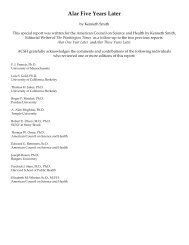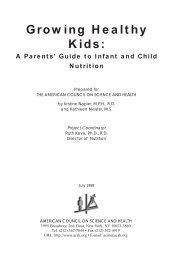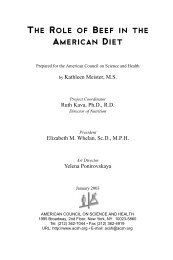Brominated Flame Retardants - American Council on Science and ...
Brominated Flame Retardants - American Council on Science and ...
Brominated Flame Retardants - American Council on Science and ...
You also want an ePaper? Increase the reach of your titles
YUMPU automatically turns print PDFs into web optimized ePapers that Google loves.
DecaBDE in the Envir<strong>on</strong>ment<br />
DecaBDE, largely because of its physical properties,<br />
does not pose a significant risk to the envir<strong>on</strong>ment.<br />
Sunlight does not degrade decaBDE. (Jafvert<br />
<strong>and</strong> Hua 2001) DecaBDE is poorly soluble, <strong>and</strong> its<br />
presence in natural waters is mainly associated with<br />
suspended particulate matter, which is an important<br />
carrier for all PDBE species. (de Boer 2003)<br />
DecaBDE has a str<strong>on</strong>g affinity to bind to organic<br />
carb<strong>on</strong> in the water column <strong>and</strong> sediment. (Hardy,<br />
2002a) Most studies of the c<strong>on</strong>centrati<strong>on</strong>s of PBDE<br />
in the water column have failed to find detectable<br />
levels of these compounds. DecaBDE does not<br />
accumulate in wildlife or food <strong>and</strong> unlike other persistent<br />
organic chemicals has not been reported to<br />
occur in wildlife or sediments. (Searl 2003)<br />
C<strong>on</strong>cerns have been raised over the potential for<br />
decaBDE to act as a source for tetra- <strong>and</strong><br />
pentaBDE. Researchers at the University of<br />
Victoria, Canada c<strong>on</strong>clude that the distributi<strong>on</strong> of<br />
“penta species” found in the envir<strong>on</strong>ment near<br />
urban <strong>and</strong> industrial regi<strong>on</strong>s arise from a weighted<br />
mix of commercial penta- <strong>and</strong> octaBDE mixtures in<br />
present use rather than from envir<strong>on</strong>mental<br />
debrominati<strong>on</strong> of decaBDE. (Rayne <strong>and</strong> Ik<strong>on</strong>omou<br />
2002)<br />
Dutch researchers report similar results. In a study<br />
of the occurrence of PBDEs in the aquatic envir<strong>on</strong>ment<br />
of the Netherl<strong>and</strong>s, UK, Irel<strong>and</strong>, <strong>and</strong> the<br />
southern North Sea, sediment core analyses c<strong>on</strong>firm<br />
a decaBDE increase. However, a parallel increase<br />
of penta-mix-related c<strong>on</strong>geners was not found,<br />
except in <strong>on</strong>e Norwegian core. Because indicati<strong>on</strong>s<br />
of increasing n<strong>on</strong>a- <strong>and</strong> octaBDEs were not found,<br />
it is unlikely that penta- <strong>and</strong> hexaBDEs are being<br />
formed from decaBDE, unless at a very slow rate.<br />
The results support the view that decaBDE in the<br />
envir<strong>on</strong>ment is not resp<strong>on</strong>sible for the presence of<br />
penta-product comp<strong>on</strong>ents in biota (fish, breast<br />
milk, etc.). (de Boer 2001)<br />
Most important, PBDEs occur naturally. Several<br />
dozen are known to be marine natural products –<br />
mainly sp<strong>on</strong>ge metabolites – <strong>and</strong> at least two such<br />
natural PBDEs are identical to synthetic PBDEs.<br />
These two natural PBDEs were recently isolated<br />
from whale blubber (from a True’s beaked whale,<br />
Mesoplod<strong>on</strong> mirus) <strong>and</strong> shown by C-14 isotopic<br />
analysis to be naturally produced <strong>and</strong> not synthetic.<br />
The PBDEs having both natural <strong>and</strong> anthropogenic<br />
origins are methoxylated PBDEs MeO-BDE-17 <strong>and</strong><br />
MeO-BDE-68. (Reddy 2004, Teuten 2005) The significance<br />
of the findings are this: when PBDEs are<br />
found in fish <strong>and</strong> marine mammals, it is entirely<br />
possible, even likely, that they are of natural origin.<br />
DecaBDE itself, however, has yet to be found to be<br />
a marine (sp<strong>on</strong>ge or bacterial) natural product.<br />
C<strong>on</strong>clusi<strong>on</strong>s<br />
There is no credible medical or scientific basis up<strong>on</strong><br />
which to support a decaBDE flame-retardants ban.<br />
Studies have failed to dem<strong>on</strong>strate any health risks to<br />
the general populati<strong>on</strong>. Banning flame retardants,<br />
though, has the dire potential to increase the risk of<br />
death from fire <strong>and</strong> raise the number of associated<br />
injuries.<br />
DecaBDE’s flame-retardant <strong>and</strong> life-saving properties<br />
are undeniable. By reducing the incidence of fires <strong>and</strong>,<br />
perhaps more important, by giving occupants valuable<br />
extra time to flee a fire, PBDEs are a clear benefit to<br />
public health in reducing fire injuries <strong>and</strong> fatalities in the<br />
United States <strong>and</strong> worldwide. Finding trace amounts in<br />
the human body or in envir<strong>on</strong>mental samples is not an<br />
indicati<strong>on</strong> of harm. Even studies of human breast milk<br />
failed to show adverse effects <strong>on</strong> infants or children.<br />
Furthermore, when interpreting biom<strong>on</strong>itoring data as a<br />
measure of the background level of chemical exposures<br />
from the envir<strong>on</strong>ment, Dennis Paustenbach <strong>and</strong><br />
David Galbraith offer an important caveat in<br />
Biom<strong>on</strong>itoring: Measuring Levels of Chemicals in<br />
People – <strong>and</strong> What the Results Mean: to wit, since in<br />
most cases the source of the chemical being measured<br />
in the biological samples will not be known, there is<br />
also a large risk of misinterpreting the data, <strong>and</strong> perhaps<br />
the most comm<strong>on</strong> mispercepti<strong>on</strong> is that the mere<br />
detecti<strong>on</strong> of a chemical in our bodies suggests a health<br />
hazard rather than simply providing a measure of exposure.<br />
(Paustenbach 2005)<br />
The efforts to ban decaBDEs, in sum, are misguided.<br />
Were such bans adopted, they would have the potential<br />
to engender very real <strong>and</strong> potentially tragic threats<br />
to public health from fires that would otherwise have<br />
been prevented or delayed with the use of products<br />
incorporating brominated flame retardants. By any<br />
measure, the benefits to public health <strong>and</strong> safety of<br />
decaBDEs outweigh the risks related to their producti<strong>on</strong><br />
<strong>and</strong> use.










